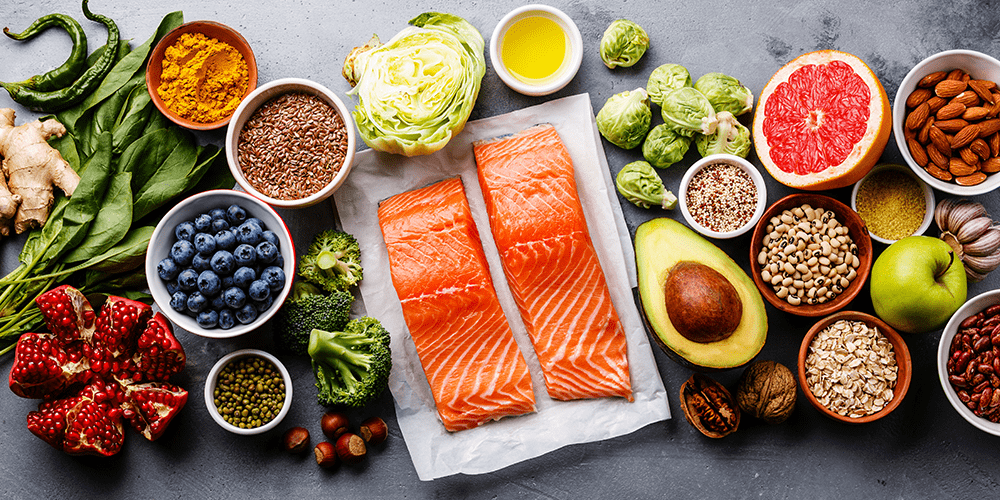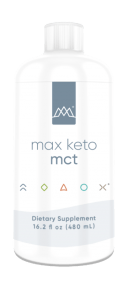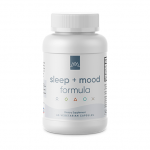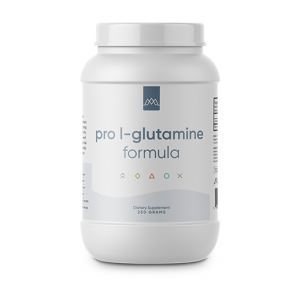Skip to:
- Strategy 1: Eat a Whole Foods Diet
- Strategy 2: Exercise Smartly
- Strategy 3: Take Supplements to Complement
- Strategy 4: Build Healthy Lifestyle Factors
Heavy Weights & Protein Shakes, but Zero Gains?
Here’s how to Build Muscle, Naturally
If you want to build muscle, you hit the gym 4-5 times a week, most likely lifting heavy weights, followed by chugging a hulking protein shake. You fuel-up on foods like egg whites and skinless chicken breast at meals and snacks.
At least that’s what you might imagine if you visit any nearby gym and observe the focused, muscular men and women determined to get strong as if that was their favorite hobby.
The truth is that to build muscle—and maintain strength—requires the balancing of several physiological aspects.
When someone says they want to gain weight, they typically mean they want to build muscle and lose fat, but finding that balance can become a challenge.
That’s because when you lose weight, you also potentially lose muscle mass. Research shows weight loss reduces muscle mass, but not strength.
At the same time, inactive adults have a 3-8% loss of muscle mass every decade. Along with muscle loss comes a decreased resting metabolic rate and fat accumulation. The result: You lose muscle and gain fat.
But that fate isn’t inevitable. You can reverse that deterioration with resistance training. Studies show even among older women with sarcopenic obesity (low muscle mass and either low muscular strength or low physical performance along with obesity), 16 weeks of resistance training improved weight loss, muscle strength, and functional capacity.
In other words, nearly everyone can lift weights to gain muscle provided you do it safely, with proper form, and with optimal weight levels.
Everyone has different requirements to optimize muscle gain, and consider discussing additional strategies with your healthcare professional. At the same time, these four strategies provide a solid foundation to build muscle and get lean, and (just as importantly) maintain those muscle gains and fat losses.
Effective Ways to Build Muscle and Maintain Strength
Strategy 1: Eat a Whole Foods Diet
A healthy, well-designed diet rich in nutrient-dense whole foods becomes the best way to build muscle. Even if you can do everything else correctly (including following the ideal workout plan), if you aren’t making food a high priority, you won’t get optimal muscle-building results.
The ideal diet to build muscle includes plenty of antioxidant-rich, low-sugar plant foods combined with anti-inflammatory wild-caught fish, walnuts, chia seeds, and other foods rich in protein and healthy fats.
Researchers note that weight training can increase the short-term inflammatory response while improving inflammation long-term. The omega-3 fatty acids in wild-caught fish and fish oil can help better manage that inflammatory response so you experience better post-exercise recovery while reducing symptoms like soreness.
MaxLiving Core and Advanced Plans include plenty of antioxidant-rich, anti-inflammatory, nutrient-dense foods to get and stay lean, muscular, and healthy.
On workout days, focus more on the Core Plan, which includes more protein to build muscle; it also includes more healthy carbohydrate options. On non-workout days, stick with the Advanced Plan, which includes plenty of healthy dietary fat.
If you prefer, you can keep the Core or Advanced plan consistently, but juxtaposing both plans might be optimal if you want to gain muscle.
While the Core Plan is practical for just about everybody, the Advanced Plan follows a similar structure with some modifications, including increasing your intake of healthy fats, moderating your intake of protein, and eliminating sugars, grains, and higher-sugar fruits.
On the Core Plan during workout days, you’ll want to focus on:
- Sufficient protein from clean sources
- Healthy dairy sources, such as unsweetened grass-fed yogurt
- Healthy fats including wild-caught fish
- Plenty of colorful vegetables
- Nutrient-dense fruits, especially berries and other low-sugar fruits
- Nuts, seeds, and nut and seed butter
- Legumes, sweet potatoes, and gluten-free grains including brown rice
On the Advanced Plan (days you’re not working out), you’ll want to focus on:
- Quality fats, including wild-caught fish, grass-fed beef, nuts, seeds, and nut and seed butter
- Good amounts of (but not excessive) protein
- Healthy oils including extra-virgin coconut and olive oils
- Approved carbohydrates, including leafy and cruciferous vegetables and low-sugar fruits like berries
You’ll want to eat enough food to support muscle growth without overeating. Whether you eat around your workout depends. Some people can lift weights on an empty stomach, whereas others feel more energetic with a light meal or nutrient-rich snack before a workout.

 Ideally, you’ll supplement the nutrient-rich Core and Advanced plans with a multivitamin (for men or women) to cover the nutrient bases you might not be getting from food and an omega-3 formula to manage inflammation levels.
Ideally, you’ll supplement the nutrient-rich Core and Advanced plans with a multivitamin (for men or women) to cover the nutrient bases you might not be getting from food and an omega-3 formula to manage inflammation levels.
Talk with your healthcare professional about additional nutrients, including vitamin D and magnesium that can support muscle growth and overall health.
Consider MaxLiving Daily Essentials. Your daily nutrient support essentials conveniently packed in daily packets.
Strategy 2: Exercise Smartly
Once you’ve dialed in your diet, you’ll want to incorporate the right exercise. Spending 20 minutes on the treadmill isn’t going to cut it. To build muscle, you’re going to need to step it up and sweat a little.
While endurance- and resistance-type exercise helps preserve muscle mass during weight loss, resistance-type exercise also improves muscle strength.
That’s not all. In one study entitled, “Resistance training is medicine: effects of strength training on health,” researchers note the many other benefits from lifting weights and building muscle. Several of the health conditions resistance training can improve include:
- Type 2 diabetes
- Visceral fat
- cardiovascular health
- Blood pressure
- Lipid profile (including HDL and LDL cholesterol)
- Bone mineral density
- Low back pain
- Arthritis
- Fibromyalgia
- Reversing specific aging factors in skeletal muscle
Work with a personal trainer to develop a resistance-training routine that optimizes form, accounts for your specific condition, and utilizes the correct level of weight resistance to gain muscle safely and effectively.
For the best results, combine weight resistance with high-intensity interval training (HIIT). As the name implies, HIIT intermittently utilizes all-out intensity immediately followed by a low-intensity exercise or rest in a very short time.
Researchers find HIIT effective for fat loss, managing disease, like type 2 diabetes, and building muscle. In one study, overweight and obese participants increased muscle size during three weeks of HIIT.
Best of all, you can get a workout in just minutes, making HIIT perhaps the most efficient, time-effective exercise possible.
Finding the right program becomes crucial for success. With MaxT3, we’ve combined focused, intense workouts at different levels that you can do in just 12 minutes to get lean, build muscle, and look and feel your best.
Strategy 3: Take Supplements to Complement
You gain muscle with resistance training; you support those gains with nutrient-dense foods. Supplements are intended to complement those efforts by optimizing muscle growth.
In other words, contrary to what some manufacturers want you to believe, using specific supplements won’t help you build muscle unless you’re doing resistance training.
In that case, some evidence does show a few intelligently designed supplements can benefit muscle growth. Among them include:
 The branched-chain amino acids (BCAA) leucine, isoleucine, and valine have earned their claim to fame over the past few years among weightlifters and athletes. Research shows that BCAAs can increase muscle mass while limiting exercise-related damage. Leucine especially earns its glory: This BCAA serves as a substrate for the synthesis of new muscle protein and as a signal to initiate muscle protein synthesis, making this the key player among the three BCAAs. (Most BCAA supplements contain more leucine than isoleucine and valine for that reason.) For BCAAs with no fillers or artificial sweeteners try Strength & Recovery Complex by MaxLiving.
The branched-chain amino acids (BCAA) leucine, isoleucine, and valine have earned their claim to fame over the past few years among weightlifters and athletes. Research shows that BCAAs can increase muscle mass while limiting exercise-related damage. Leucine especially earns its glory: This BCAA serves as a substrate for the synthesis of new muscle protein and as a signal to initiate muscle protein synthesis, making this the key player among the three BCAAs. (Most BCAA supplements contain more leucine than isoleucine and valine for that reason.) For BCAAs with no fillers or artificial sweeteners try Strength & Recovery Complex by MaxLiving.- This go-to supplement for bodybuilders has some scientific credibility. Combined with resistance training, a systematic review and meta-analysis of randomized controlled trials found creatine supplementation could increase lean tissue mass and muscular strength, even in older individuals. That said, not all studies conclude positively, and researchers express concern about the safety of long-term, higher doses. Talk with your healthcare professional before you use therapeutic doses of creatine.
- Medium-chain triglycerides (MCTs).
 This unique fatty acid, which bypasses typical fat metabolism and heads straight to your liver, provides an excellent fuel source to build muscle. Research shows MCTs can increase mitochondria (the little energy plants within your cells) and metabolism while improving exercise performance providing an optimal fuel source as you build muscle. One study found 6 grams of MCTs along with leucine-rich amino acids (such as BCAAs) and vitamin D at dinner could improve muscle strength and function in older people. You can get MCTs in extra-virgin organic coconut oil or as a stand-alone supplement like Max MCT by MaxLiving.
This unique fatty acid, which bypasses typical fat metabolism and heads straight to your liver, provides an excellent fuel source to build muscle. Research shows MCTs can increase mitochondria (the little energy plants within your cells) and metabolism while improving exercise performance providing an optimal fuel source as you build muscle. One study found 6 grams of MCTs along with leucine-rich amino acids (such as BCAAs) and vitamin D at dinner could improve muscle strength and function in older people. You can get MCTs in extra-virgin organic coconut oil or as a stand-alone supplement like Max MCT by MaxLiving. - L-glutamine. Among its roles, this workhorse amino acid supports gut health, immunity, and post-exercise recovery. During intense exercise, muscle glutamine levels can decrease. One study found people who supplemented with L-glutamine had less muscle soreness and better recovery after exercise. L-glutamine comes in an easy-to-mix powder that blends well with water or in your protein shake.
That raises a question: Do you need a protein shake to build muscle?
You might think so, considering how many bodybuilders and gym-focused folks suck them down after a workout. Brilliant marketing suggests to get lean and ripped, you need a protein shake before, during, and after a workout.
The short answer is that no, you don’t. You can support muscle protein synthesis and recovery by eating whole, protein-rich foods after a heavy lifting session. Of course, not everyone feels hungry or has an appetite after a workout, and some people don’t like the hassle of packing food for the gym. In these instances, using a shake can provide a faster-absorbing source of protein to support muscle health.
Whey protein is especially fast-absorbing, making it ideal after a workout. One study found that men and women who consumed a whey shake post-workout improved lean body mass and muscle protein synthesis better than a soy protein shake or carbohydrates. One reason for that was the aforementioned amino acid leucine.
The right whey protein becomes crucial to get those benefits. Many commercial protein powders contain artificial sweeteners and other inferior ingredients and other problems that inhibit their efficacy. Always look for a grass-fed, hormone-free whey protein that contains at least 20 grams of protein per serving like Protein by MaxLiving.
Without the right diet and exercise, muscle-supporting supplements won’t do much. But if you’re focused on eating well and getting the right workout, a few intelligently chosen supplements might be the needle mover to help you build and sustain muscle more effectively.
Strategy 4: Build Healthy Lifestyle Factors
You might build muscle in the gym, but what happens outside of your workout will make or break your muscle-building and maintenance plan. Among the strategies that can complement gaining muscle include:
 Studies associate poor sleep quality and short sleep duration with an increased risk for muscle mass reduction. Conversely, optimal sleep can influence muscle strength. Aim for at least eight to nine hours of quality, uninterrupted sleep every night. Consider a Sleep+Mood Supplement, like MaxLiving’s to help you naturally get the sleep your body needs.
Studies associate poor sleep quality and short sleep duration with an increased risk for muscle mass reduction. Conversely, optimal sleep can influence muscle strength. Aim for at least eight to nine hours of quality, uninterrupted sleep every night. Consider a Sleep+Mood Supplement, like MaxLiving’s to help you naturally get the sleep your body needs.- Stress management. Research shows that stress hormones can negatively impact skeletal muscle. For instance, among elderly people, stress can induce an earlier decline in muscle strength that increases fall and fracture risks. Managing stress for you might include brisk walking, deep breathing, or spending time with a friend.
- Rest and recovery. Recovery demands optimal sleep, but also taking days off from the gym, engaging socially, finding active relaxation (such as meditation), and complementing weight resistance with other forms of exercise including restorative yoga.
- Chiropractic care.
 Visiting a chiropractor can provide pain relief and other benefits as you build muscle. One study among elite athletes found a single session of chiropractic care also increased muscle strength. A chiropractor can also help you individualize your dietary and workout plan to optimize gains.
Visiting a chiropractor can provide pain relief and other benefits as you build muscle. One study among elite athletes found a single session of chiropractic care also increased muscle strength. A chiropractor can also help you individualize your dietary and workout plan to optimize gains.
Combine these strategies and you’ve got an ideal formula to lose body fat and gain muscle.
Getting strong and lean doesn’t happen overnight. As you incorporate these strategies, remember these are tools that will serve you throughout life rather than quick fixes to build muscle. Everyone is unique, so talk to your chiropractor or other healthcare professional about additional strategies and modifications to this plan to fit your needs and goals.
One final caveat: Before you begin or modify any exercise program, especially more intense plans, please consult with your healthcare practitioner.




